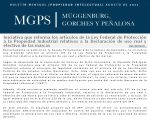By: Adrian Lopez Casab
The special purpose acquisition companies (“SPACs” for its acronym in English “Special Purpose Acquisition Company”) are a vehicle that, although they have existed since the nineties in the capital market, have been a trend and have taken on special relevance in recent years, particularly due to the changes in the regulation regarding this type of company promoted by the Securities and Exchange Commission (“SEC”) of the United States of America, and the adoption of this business model by the large banks and funds of said country. This first boost to the figure limited, to a certain extent, the perception of risk by investors in this type of company, which led to its regulation at the international level.
For the listing of the SPACs, it is necessary for a promoter agent to make an initial public offering (“IPO”) to raise capital from the large investing public, and with the resources obtained by said IPO, through it, acquire or merge with one or more existing companies, whether they are public or private companies. The SPACs usually bring together the interests of people specialized in a certain sector, and generally at the time of carrying out the IPO they already have one or more prospects of companies to acquire or merge (“targets”); however, these targets are usually not disclosed so as not to vitiate the bidding process that is normally followed in a merger and acquisition operation. When investing in a SPAC, the investor receives the shares issued by it that correspond to the amount of his investment, and a right -but not obligation- for the acquisition or sale of shares of the SPAC in the future at a certain price (warrant). , once the acquisition or merger in question is completed. Pursuant to the foregoing, unlike other instruments, the company can be listed on a stock exchange without having a prior history of operation, so the value acquired by the SPAC in front of its investors and in the market at the time of making the IPO is equivalent to the expectation of the acquisition that it intends to make in the future, hence they are also known as "blank check companies". Once the corresponding acquisition or merger is completed, the SPAC becomes an “ordinary” company.
The foregoing also makes this figure attractive for the person or group of people who intend to raise capital, since although the IPO complies with the stock market formalities and requirements, these decrease as it is a company with no history of operation, therefore which this figure has also been used by private companies that seek to become public and for this purpose use a SPAC as a vehicle, because the aforementioned reduction in requirements and formalities also generates a decrease in the time to form an IPO, in such a way that so that once the SPAC makes its IPO, it merges with the private company that intended to go public.
Once the capital has been raised, the SPAC has a certain term to carry out the acquisition, which is generally from eighteen to twenty-four months. During said period, the money raised through the IPO is invested in low-risk instruments that are generally government bonds and specifically United States treasury bonds or some other stable market, and during said period the SPAC will only be able to dispose of the capital of work necessary for its operation focused on carrying out the corresponding acquisition or merger. Once this period is over, in case the SPAC has not carried out the acquisition or merger, the SPAC must be liquidated and the money must be returned to the investors with the returns or losses that, if applicable, it has generated, while the cost for the operation of the SPAC during said period must be absorbed by the promoting agent.
As for the target, this practice has the benefit of negotiating its sale to a SPAC, the possible agreement for a premium on the acquisition of shares at the time of acquiring them, a practice that is usual due to the time limit that the SPAC has to be able to complete the operation.
At the moment, only two IPOs of SPACs have been carried out in the Mexican stock exchanges, although there is a record of Mexican investors carrying out IPOs through this vehicle in the US stock exchanges, just for comparison, only in 2021 in the United States six hundred went public thirteen SPACs. This lack of SPACs in Mexico could be attributed mainly to two factors: first, the considerable lower number of institutional investors in Mexico (mainly made up of AFOREs) compared to the US stock market, as well as their more conservative profile in their investments, being the SPACs a vehicle in the short-medium term and notably more risky; and secondly and as mentioned at the beginning of this article, the recent growth in the use of this vehicle in the United States is due to a change in the SEC regulation, although in Mexico the stock market regulation was modified in 2017 to allow its listing, its operation, however, complies with the general rules on the stock market, so the regulatory environment also makes it more attractive to carry out this type of IPOs on international stock exchanges.





